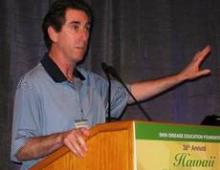WAIKOLOA, HAWAII – Cellulite therapy may finally be moving out of the dark ages of overhyped claims made on behalf of interventions of little or no value to an era of treatments that actually work.
And what appears to work, according to Dr. Michael S. Kaminer, are therapies that cut the fibrous septae tethering the dermis to deeper tissues.
"I think it’s likely that the vertical pull of the fibrous septae tends to pull down on the cellulite in the skin and causes the cellulite dimples," he explained at the Hawaii Dermatology Seminar sponsored by Skin Disease Education Foundation (SDEF).
The fibrous septae theory of the etiology of cellulite is relatively new. It has gained substantial credence as a result of encouraging clinical trial data showing long-term effectiveness for two devices targeting cellulite via severing fibrous septae: the Cellulaze 1,440-nm Nd:YAG laser and the Cabochon Aesthetics controlled subcision system for subdermal undermining, according to Dr. Kaminer, who is a managing partner at SkinCare Physicians, Chestnut Hill, Mass.
Cellulaze, developed by Cynosure, recently received Food and Drug Administration marketing approval for the treatment of cellulite. It is also approved across Europe for this indication. The Cabochon device for subcutaneous release of fibrous septae in patients with cellulite is still in clinical trials.
Dr. Kaminer said Americans spend an estimated $3 billion annually on ineffective treatments for cellulite. These therapies, many of which have been the beneficiaries of claims he termed "outrageous," aim to either reduce or redistribute subcutaneous fat or to thicken the skin surface through methods such as suction massage, which creates skin edema that temporarily camouflages the cellulite dimples. Among the myriad of available therapies are skin wraps, various injectables, and focused ultrasound. But the effect sizes are small and the results, if any, last for a matter of weeks.
"Until very recently, there was absolutely no reason to pay attention to cellulite except to counsel patients as to the fact that they shouldn’t waste their money, unless they feel good about wasting their money," Dr. Kaminer said.
The situation has changed dramatically with the emergence of fibrous septae as the prime therapeutic target. Cellulaze can be used for laser lipolysis; however, in addition, the handpiece for the cannula can be turned in such a way that the laser beam can be used like a saw to cut through the fibrous septae, with resultant long-term improvement in cellulite.
In U.S. clinical trials, the average increase in skin thickness following Cellulaze therapy was 23% at 1 month and 27% at 1 year. Skin elasticity improved over baseline by 32.5% at 1 month and 21% at 1 year. Sixty-eight percent of patients demonstrated significant improvement in cellulite based upon analysis of photographs, as did 65% when assessed by Vectra 3D surface imaging.
Patient self-evaluations rated the results as good to excellent at 1 month in 76% of cases. Physicians judged the results as good to excellent in 69% of cases. These results have held up at 1 year of follow-up, noted Dr. Kaminer, who also is with the dermatology departments of Yale University, New Haven, Conn.; Dartmouth College, Hanover, N.H.; and Brown University, Providence, R.I.
The downside of Cellulaze is that it is an invasive therapy that requires tumescent anesthesia. And given that the history of the field of cellulite therapy is one of hype far in excess of reality, Dr. Kaminer indicated that a healthy skepticism is appropriate.
"For me, I’m going to approach this with caution. I think Cellulaze is a great idea, and I think it gets to what many people believe is the root of cellulite. But I’d like to see it around for a little longer before we all jump on the bandwagon," he said.
The Cabochon system draws a small section of skin affected by cellulite into a handpiece so that a percutaneously inserted cutting tool can be utilized to cut the fibrous septae. Dr. Kaminer was an investigator in a two-site, 56-patient clinical trial with a 6- to 12-month follow-up.
In independent blinded physician review of before and after photos, 78% of patients were judged to have improved at least one full grade in severity at 6 months, such that, for example, those whose cellulite was rated severe at baseline were judged to have moderate or mild cellulite at follow-up.
At baseline, the average cellulite severity score was about 4.5 on a 0-6 scale. At 90 days, the average severity score had dropped to 3, and at 180 days to roughly 2.5. Ninety-four percent of patients were rated by independent physicians as having improved by at least 1 point on the 0-6 scale.


